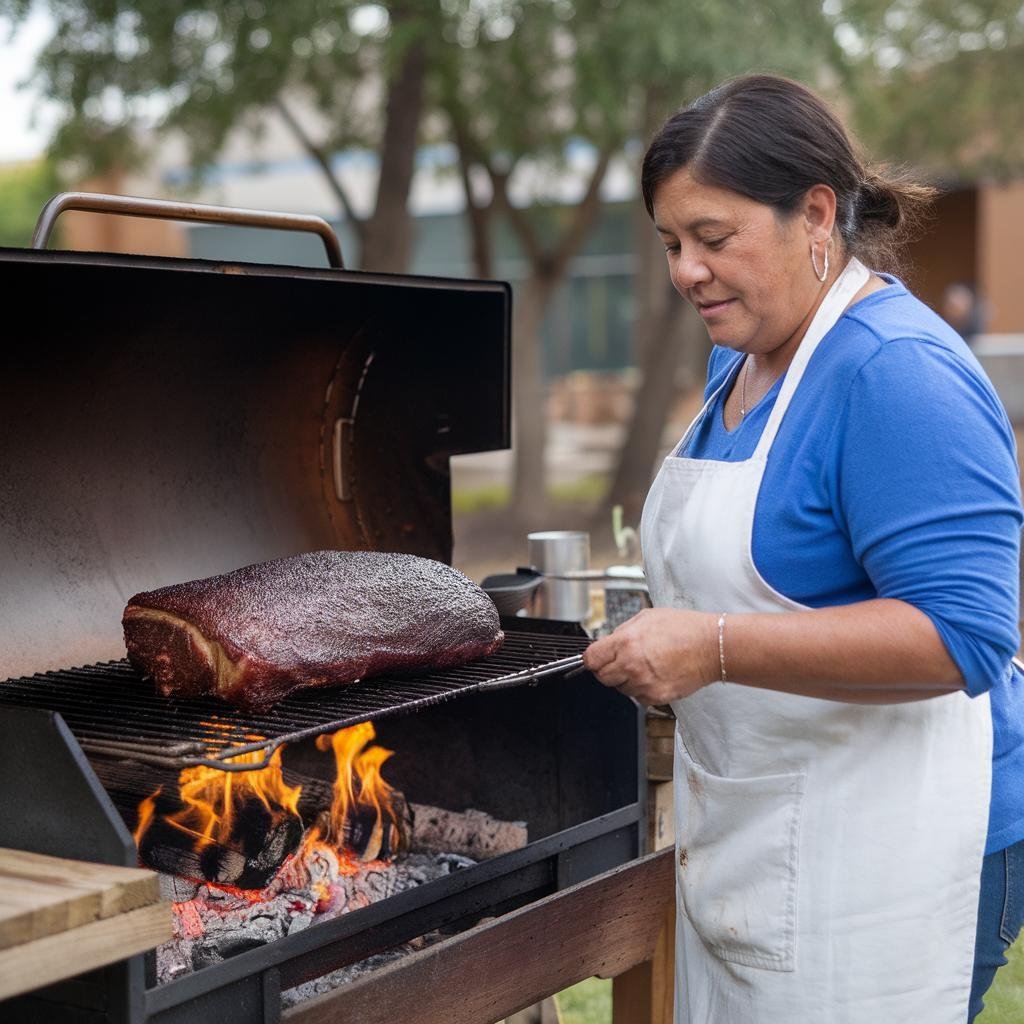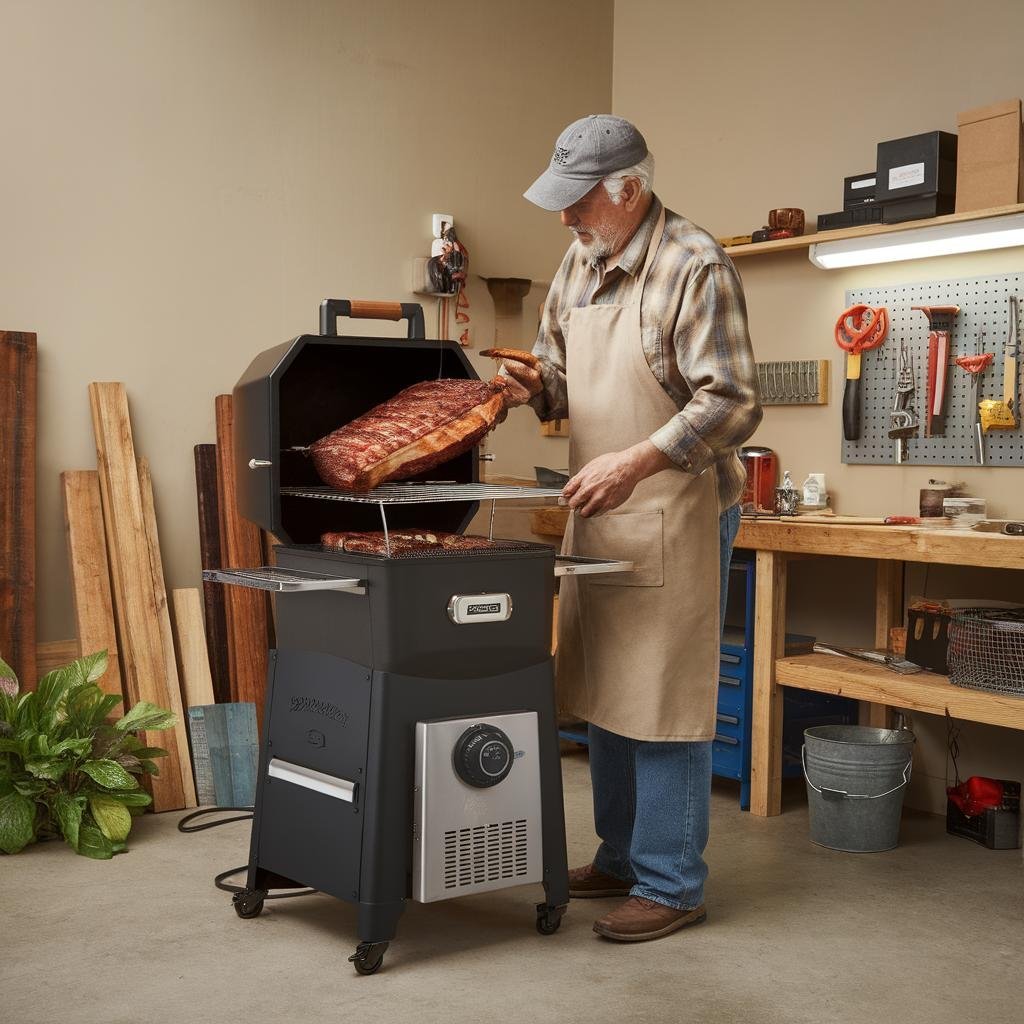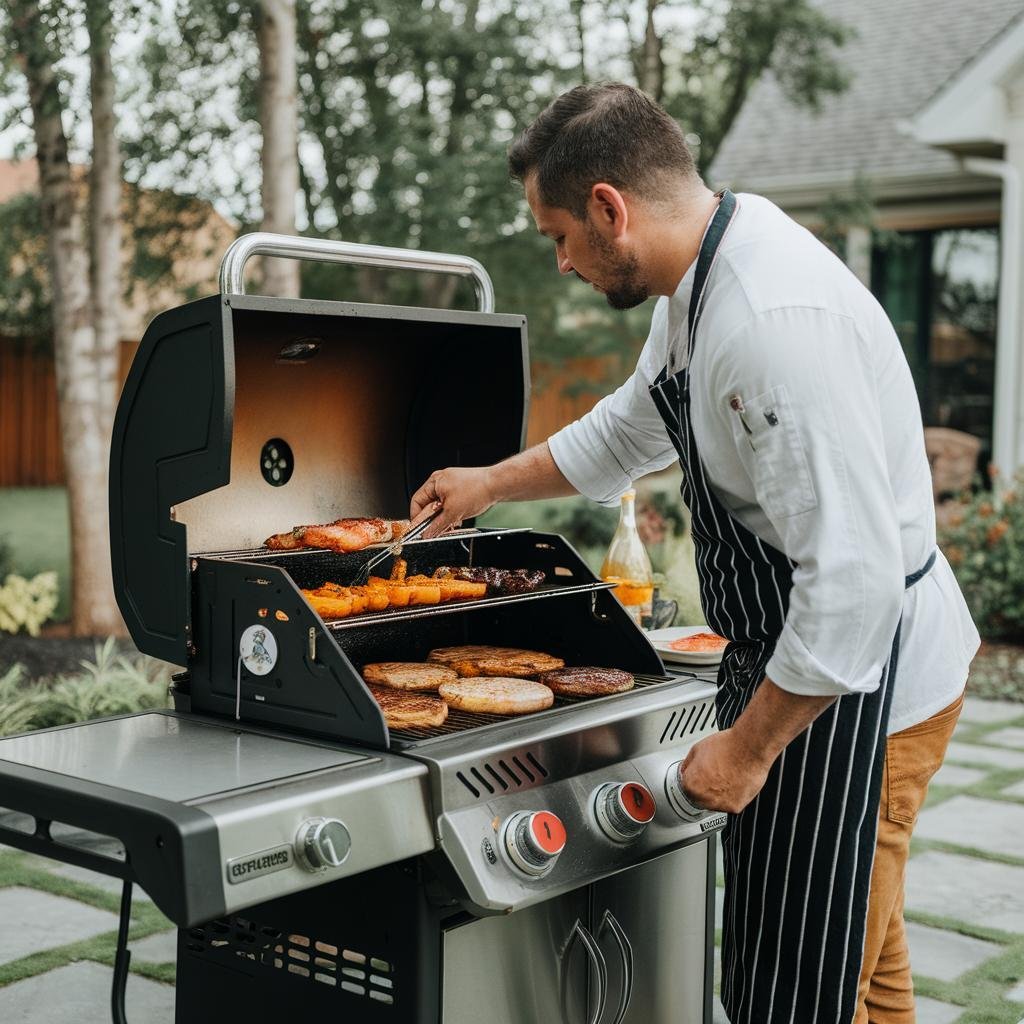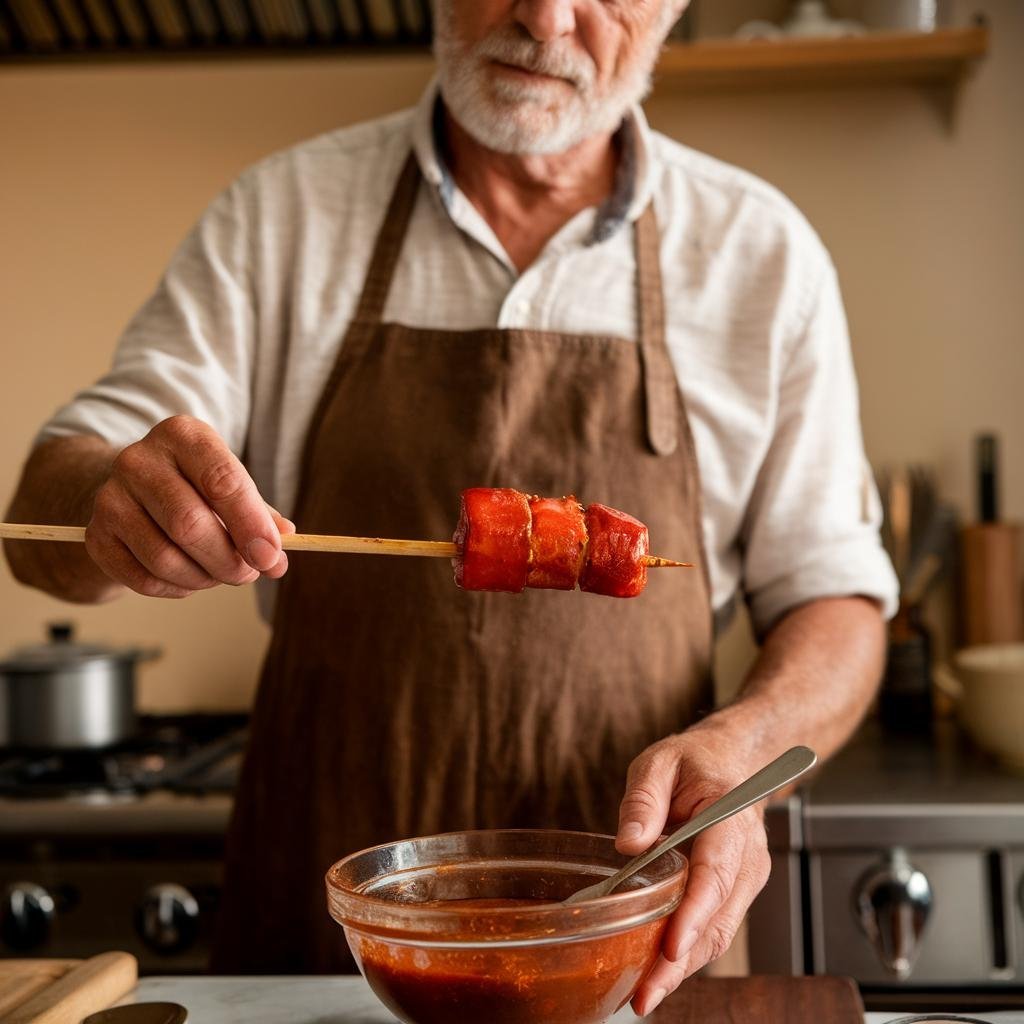Disclosure: This Post Contains Affiliate Links; We earn a commission on purchases.
Are you a BBQ enthusiast looking to elevate your smoking game? Look no further than the low and slow smoking technique. By cooking meat at low temperatures for an extended period, you can achieve tender and flavorful results that will leave your taste buds craving for more.
Low and slow smoking involves cooking meat at temperatures between 225-250°F, allowing the smoke to penetrate the meat and infuse it with smoky goodness. This method is perfect for tough cuts of meat like brisket or pork butt, as the low heat breaks down collagen and transforms them into melt-in-your-mouth delicacies.
To achieve the best results with low and slow smoking, it’s important to maintain precise temperature control and choose the right smoking wood flavors that complement your meat. Whether you’re using a pellet smoker or traditional charcoal grill, mastering this technique will take your BBQ smoking to the next level.
Key Takeaways:
- Low and slow smoking involves cooking meat at low temperatures for an extended period.
- This technique allows smoke to penetrate the meat, resulting in tender and flavorful results.
- Precise temperature control and smoking wood flavors are essential for success.
- Low and slow smoking is ideal for tough cuts of meat like brisket or pork butt.
- Mastering the low and slow smoking technique will elevate your BBQ game.
The Science Behind Low and Slow Smoking
Low and slow smoking is not just a cooking technique; it’s a scientific process that transforms tough cuts of meat into tender, flavorful delicacies. Understanding the science behind this method can help you master the art of smoking meats.
Collagen breakdown: When meat is cooked at low temperatures for an extended period, collagen, a protein responsible for the toughness of meat, breaks down into gelatin. This breakdown process results in a tender and melt-in-your-mouth texture that meat enthusiasts crave.
Moisture retention: One of the key benefits of low and slow smoking is its ability to retain moisture in the meat. The slow cooking process prevents excessive evaporation, ensuring that the meat stays juicy and succulent.
Smoke penetration: Low and slow smoking allows for ample smoke penetration into the meat. The longer cooking time provides more opportunities for the smoke to infuse its flavor into every inch of the meat, resulting in a delicious smoky taste profile.
Temperature control: Precise temperature control is crucial when practicing low and slow smoking. Maintaining a consistent temperature between 225-250°F ensures that the meat cooks evenly and thoroughly, allowing the collagen breakdown and smoke flavor infusion to occur optimally.
The science behind low and slow smoking reveals the intricate processes that take place during this cooking technique. The breakdown of collagen, moisture retention, smoke penetration, and temperature control all contribute to the exceptional tenderness and flavor of smoked meats.
Continue reading to discover the benefits of low and slow smoking in section 3.
The Benefits of Low and Slow Smoking
The low and slow smoking method offers several benefits for achieving tender and flavorful smoked meats. Let’s explore the advantages of this technique:
- Tenderness: Low and slow smoking can transform tough cuts of meat into tender and juicy masterpieces. The extended cooking time at low temperatures allows the collagen in the meat to break down, resulting in a melt-in-your-mouth texture.
- Flavor Absorption: With low and slow smoking, the meat has ample time to absorb the flavors of the smoke, creating a rich and well-rounded taste profile. The slow cooking process allows for deeper flavor penetration, enhancing the overall dining experience.
- Temperature Control: Precise temperature control is crucial for successful low and slow smoking. By maintaining a consistent temperature between 225-250°F, you can ensure even cooking and prevent the meat from drying out or becoming overcooked.
- Smoke Flavor: The extended smoking time in low and slow smoking allows for intense smoke flavor development. The longer exposure to smoke infuses the meat with a delicious smoky essence, enhancing its overall taste and aroma.
- Smoking Time: Low and slow smoking requires patience but yields exceptional results. The extended cooking time allows the flavors to develop fully, resulting in tender, juicy, and flavorful meats that will impress your family and guests.
To better understand the benefits of low and slow smoking, take a look at the table below comparing it to the hot and fast approach:
| Advantages | Low and Slow Smoking | Hot and Fast Smoking |
|---|---|---|
| Tenderness | High | Medium |
| Flavor Absorption | High | Medium |
| Temperature Control | Precise | Challenging |
| Smoke Flavor | Intense | Subtle |
| Smoking Time | Long | Short |
As you can see, low and slow smoking offers superior tenderness, flavor absorption, temperature control, smoke flavor, and smoking time compared to the hot and fast method. These benefits make it a preferred choice for many barbecue enthusiasts seeking delicious and succulent smoked meats.
The Pros and Cons of Low and Slow Smoking
Low and slow smoking offers a range of advantages and disadvantages for achieving the perfect smoked meats. Let’s take a closer look:
Advantages
- Tenderness: One of the main benefits of low and slow smoking is the tenderness it brings to the meat. Even tough cuts become succulent masterpieces as the slow cooking process breaks down collagen, resulting in a melt-in-your-mouth texture.
- Flavor Development: Low and slow smoking allows for deep flavor development. The extended cooking time allows the meat to absorb ample smoke, resulting in a rich and complex flavor profile.
Disadvantages
- Time-Intensive: Low and slow smoking is a time-intensive method that requires patience. It often takes hours or even days to achieve the desired results. However, the tender and flavorful meat is well worth the wait.
- Attention: Constant attention is needed when low and slow smoking. It’s important to monitor the temperature and adjust as needed to ensure even cooking and prevent overcooking or drying out the meat.
Achieving a crispy crust can be a challenge with low and slow smoking. However, there are additional steps and techniques that can be employed to enhance the crispiness of the final product.
“The low and slow smoking method brings out the tenderness and flavor in even the toughest cuts of meat. It’s a time-intensive process that requires attention and patience, but the results are well worth the effort.”
Now that we’ve explored the pros and cons of low and slow smoking, let’s dive into the hot and fast approach to smoking in the next section.
The Hot and Fast Approach to Smoking
The hot and fast approach to smoking involves cooking meat at higher temperatures, typically around 300-350°F, for a shorter duration. This method yields quick results, making it ideal for those looking for a faster cooking time.
The high heat creates a beautifully caramelized crust on the meat, adding flavor and texture. The intense heat rapidly sears the meat, locking in juices and creating a mouthwatering outer layer.
However, it can be challenging to maintain precise temperature control with the hot and fast method. Due to the higher cooking temperature, there is a greater risk of the meat drying out or burning if not closely monitored.
Although the shorter cooking time may result in slightly less tender meat compared to low and slow smoking, the hot and fast method can still produce deliciously juicy results if executed properly.
While the hot and fast approach may have limited smoke absorption, it compensates with a bold and intense flavor infusion, thanks to the shorter cooking time. The high heat helps concentrate the flavors and can lead to a rich and savory taste profile.
In summary, the hot and fast approach to smoking offers quick results and a beautifully caramelized crust. It requires careful attention to ensure proper temperature control and prevent overcooking. While the meat may be slightly less tender than with low and slow smoking, the flavor infusion is intensified. With the right techniques and attention to detail, you can achieve mouthwatering results with the hot and fast method.
Pros and Cons of Hot and Fast Smoking
The hot and fast smoking approach offers speedy results, with shorter cooking times compared to low and slow smoking. The high heat creates a crisp crust on the meat, adding texture and flavor. Despite the shorter cooking time, hot and fast smoking can still produce juicy results. However, there is a risk of the meat being less tender, especially if the cuts are naturally tough. Limited smoke absorption may result in a less pronounced smoky flavor. Temperature control can be challenging with the hot and fast method, requiring careful monitoring to prevent overcooking.
Pros
- Speed: Hot and fast smoking yields quicker results, making it ideal for those who want to enjoy their smoked meats sooner.
- Crust Formation: The high heat involved in hot and fast smoking creates a beautifully crisp crust on the meat, adding a satisfying texture and flavor.
- Smoke Absorption: Despite the shorter cooking time, hot and fast smoking can still infuse the meat with some smoky flavor.
- Temperature Control: While temperature control can be challenging, mastering it allows for successful hot and fast smoking and prevents overcooking.
Cons
- Tenderness: The shorter cooking time and higher heat can result in less tender meat, especially when dealing with tougher cuts.
- Smoke Absorption: Hot and fast smoking may provide limited smoke absorption, resulting in a less pronounced smoky flavor.
- Temperature Control: Maintaining precise temperature control can be more challenging with the hot and fast smoking method than with the low and slow method.
Finding the Right Approach for You
Choosing between low and slow smoking and hot and fast smoking depends on your cooking preferences and desired results. If you prioritize tenderness and deep flavor development, low and slow smoking is the way to go. It requires more time and patience but delivers succulent and well-rounded results.
On the other hand, if you’re short on time or prefer a crispier crust, hot and fast smoking may be the better option. It yields quicker results and creates a caramelized crust, although it may result in slightly less tender meat.
Consider your cooking goals and available time when deciding on the smoking approach that suits you best. Here’s a comparison of the key factors:
| Low and Slow Smoking | Hot and Fast Smoking | |
|---|---|---|
| Tenderness | Results in tender and juicy meat from tough cuts | May result in slightly less tender meat |
| Flavor Profile | Deep flavor development with ample smoke absorption | Creates a caramelized crust with limited smoke absorption |
| Cooking Time | Requires longer cooking times | Yields quicker results |
Low and slow smoking demands more attention and dedication, but it produces meat that is incredibly tender and full of smoky flavor. It’s perfect for those who appreciate the art of barbecue and have the time to invest in the cooking process.
Hot and fast smoking offers a faster alternative with a focus on achieving a crispy crust. It’s ideal for those who want quick results without compromising too much tenderness and are looking for a flavorful outer layer.
Ultimately, the choice between low and slow smoking and hot and fast smoking comes down to your cooking preferences and desired results. Whether you prioritize tenderness or crave a quick and crispy meal, you can find the perfect smoking approach that suits your taste.
Conclusion
In conclusion, both low and slow smoking and hot and fast smoking have their own advantages and disadvantages when it comes to achieving the perfect smoked meats. Low and slow smoking offers tender and juicy results with deep smoky flavors that penetrate the meat. It requires more time and attention, but the end result is well worth the effort. On the other hand, hot and fast smoking yields quicker results and creates a crispy crust on the meat, providing a different texture and flavor experience. However, it may sacrifice some tenderness and smoke absorption.
The choice between low and slow smoking and hot and fast smoking ultimately depends on your cooking preferences and desired outcomes. If you have the time and patience, low and slow smoking will deliver succulent and well-rounded results. It allows the meat to slowly break down collagen and become tender, with a rich and smoky flavor. On the other hand, if you’re short on time or prefer a crispier crust, hot and fast smoking may be the better option. It provides quicker cooking times and a caramelized crust, although the meat may be slightly less tender and have less pronounced smoky flavor.
Regardless of which method you choose, temperature control is key to achieving the desired results. Ensuring the meat is cooked at the right temperature, and using quality smoke wood flavors, will enhance the overall taste experience. So, whether you prefer low and slow smoking or hot and fast smoking, with the right techniques and attention to detail, you can elevate your BBQ game and perfect the art of smoking meats to impress your family and friends.
References

Ryan Conlon is a BBQ enthusiast and inspired chef on a journey through the smoky, savory world of outdoor cooking. Hailing from the heart of the Midwest, Ryan’s passion for grilling ignited during his early years, where family gatherings often revolved around the sizzle of the grill and the aroma of seasoned meats.







